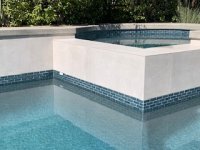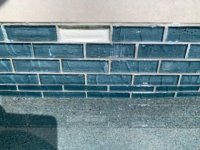All,
A pool glass pool tile just fell off yesterday afternoon and need help determining (A) best short, (B) long-term fix, and (C) interim spa water maintenance.
We remodeled our backyard about 3 years ago and refinished our pool with new coping, tile (waterline and raised wall), and surface. The finished job looked great, but prior to this tile falling off, I noticed that the tile (which fell off) seemed darker than those around it and, now that it fell off, I found algae behind the tile. After further assessing the situation the open tile socket won't dry AND the grout above the tile (between the glass pool tile and the raised porcelain beige tile) is soft/wet, suggesting there may be a leak from the spa behind the porcelain tile. During the remodel (for the 20+ year old pool) the concrete of this same section inside the spa was compromised and the contractor used waterproof concrete to fill the weakened sections, but it may not have been an adequate job.
I suspect the right long term answer is to remove the large porcelain tile and explore the root cause of the issue, BUT I can't image doing that at this time given the snowball impact of doing so, e.g. likely breaking the porcelain tile, removing surface finish inside the spa, etc).
As such, is there a temporary short-term fix that I could implement? Is there (1) a waterproofing product (that would need to be applied on a wet surface) that I can purchase to dry the tile socket, (2) a moisture tolerant thin set or alternative adhesive that I could use to reattach the tile since it won't dry? I need some fix because on daily operation, the spa overflows into the pool and over this section of tile, so I can't operate the spillway until this is fixed.
What would be the recommended approach to investigate the root cause of the issue and implement a long-term fix?
In the meantime, what's the best way to maintain the spa water chemistry? Should I just treat it as a second pool and run the spa separately for portion of the day or night and balance the spa water chemistry separately?
I would go back to the tile installer but unfortunately is no longer in business.
Thank you for the help!
BTW, I live in San Diego, CA. Open to getting professional help in this area.
A pool glass pool tile just fell off yesterday afternoon and need help determining (A) best short, (B) long-term fix, and (C) interim spa water maintenance.
We remodeled our backyard about 3 years ago and refinished our pool with new coping, tile (waterline and raised wall), and surface. The finished job looked great, but prior to this tile falling off, I noticed that the tile (which fell off) seemed darker than those around it and, now that it fell off, I found algae behind the tile. After further assessing the situation the open tile socket won't dry AND the grout above the tile (between the glass pool tile and the raised porcelain beige tile) is soft/wet, suggesting there may be a leak from the spa behind the porcelain tile. During the remodel (for the 20+ year old pool) the concrete of this same section inside the spa was compromised and the contractor used waterproof concrete to fill the weakened sections, but it may not have been an adequate job.
I suspect the right long term answer is to remove the large porcelain tile and explore the root cause of the issue, BUT I can't image doing that at this time given the snowball impact of doing so, e.g. likely breaking the porcelain tile, removing surface finish inside the spa, etc).
As such, is there a temporary short-term fix that I could implement? Is there (1) a waterproofing product (that would need to be applied on a wet surface) that I can purchase to dry the tile socket, (2) a moisture tolerant thin set or alternative adhesive that I could use to reattach the tile since it won't dry? I need some fix because on daily operation, the spa overflows into the pool and over this section of tile, so I can't operate the spillway until this is fixed.
What would be the recommended approach to investigate the root cause of the issue and implement a long-term fix?
In the meantime, what's the best way to maintain the spa water chemistry? Should I just treat it as a second pool and run the spa separately for portion of the day or night and balance the spa water chemistry separately?
I would go back to the tile installer but unfortunately is no longer in business.
Thank you for the help!
BTW, I live in San Diego, CA. Open to getting professional help in this area.















